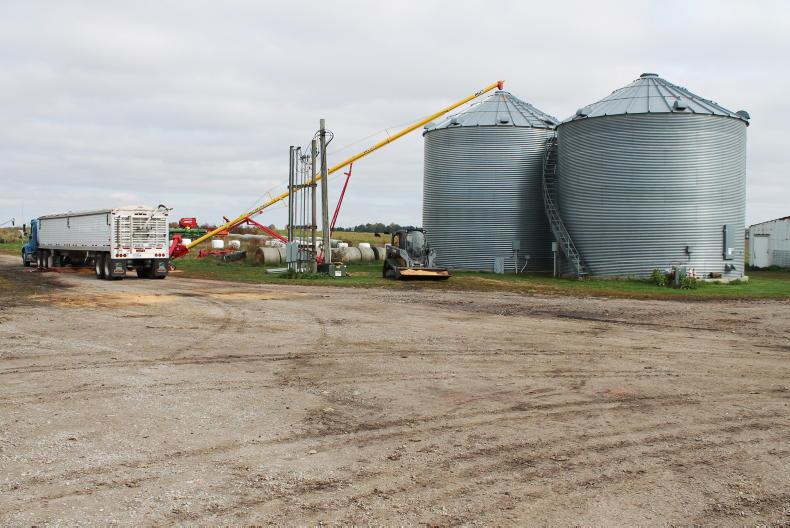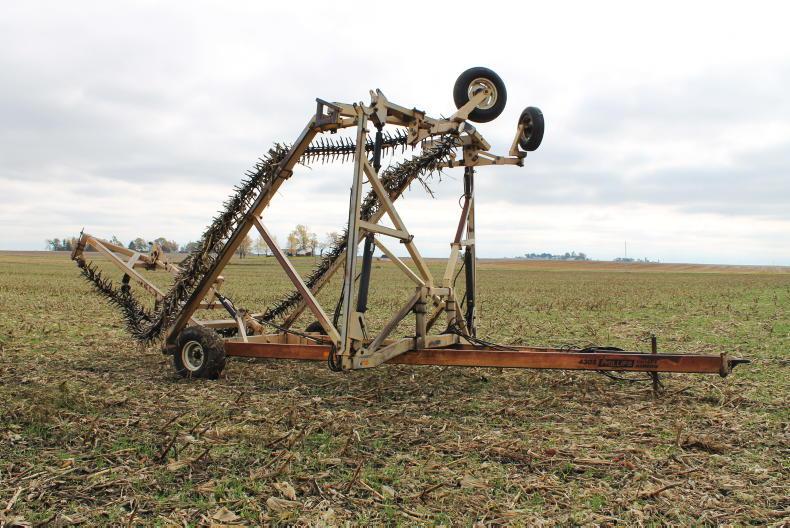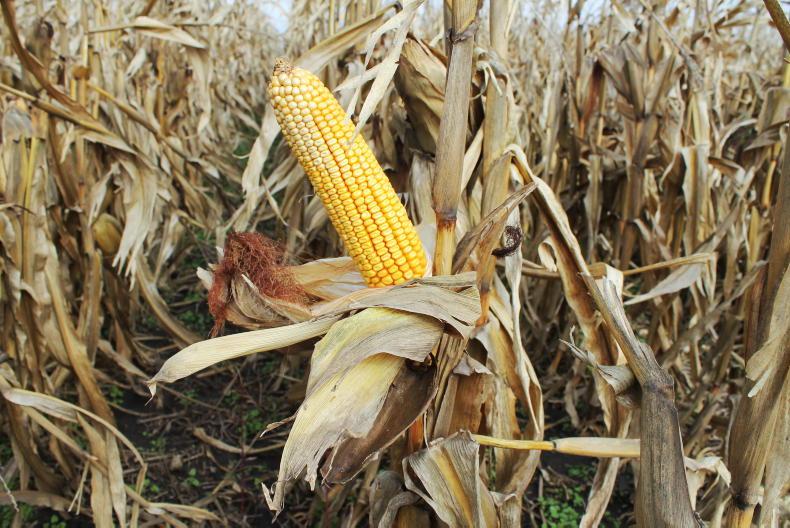The typical mindset among many farmers working some of the world’s most fertile soil in the US state of Illinois is: “This ground is so highly productive, it should not be used for anything but growing traditional crops in a conventional system.”
But Dirk Rice (61) and his son, Matt (30), dare to think differently on their 2,100ac corn (maize), soybean and suckler beef holding.
Located near Philo, Champaign County, they have introduced several conservation practices, including continuous no-till, cover crops on over half their acreage, split nitrogen application, and cornstalk grazing.
Though they admit their experimental style sometimes makes them the subject of wisecracks among neighbours, they are committed to “learning by doing”, even if that means facing issues with crop residues, planting times and outwintering.
Speaking to the Irish Farmers Journal as they wrapped up their 2023 harvest, the father and son duo whose ancestors began farming here in 1881, said that an objective approach to agriculture is “in our genes” and has become central to Dirk’s cultivation of their genetically modified (GMO) grains and Matt’s livestock business.

Dirk Rice.\ Claire McCormack
“My grandfather was very involved in farming in the 1920s. They had a five-way crop rotation of corn, soybean, wheat, oats and meadow [a hay crop]. They didn’t have tractors back then, so you had to grow enough oats to feed your horses,” said Dirk.
“He was very conservation-minded and believed in leaving areas fallow every once in a while. This was before commercial fertiliser.
“He understood the importance of cover crops too. These messages have passed down from my grandfather, to my father, to me, and now to Matt.”
Dirk started working with no-till when he came home to farm in 1984, after graduating in Agricultural Economics at the University of Illinois Urbana-Champaign (UIUC), the alma mater of his father, grandfather and grandmother too.
At the time, Dirk’s father Don ran a mixed holding comprising a maize, soybean and wheat rotation, with a small farrow-to-finish hog operation.
“I took over the hog side, which I kept going until the mid-90s, but we had two issues – there was so little livestock in the area that we didn’t have the infrastructure support, and the only veterinarian was in the university, so I got more acres and shifted strictly to cash grain.

Grain bins being filled with maize corn.\ Claire McCormack
“The traditional way here is the chisel plough, especially after corn for your cornstalks. But some of our ground is very heavy. My father quit doing deep tillage in the 1970s.
“His observation was that our heavy soil was in better shape in the spring when he planted with very minimal tillage as opposed to deep tillage. He started experimenting with no-till in the early 1980s.
“I’ve been no-tilling for a long time on soybeans. We did use one tillage pass before planting corn until three years ago; 90% of our acreage will be strictly no-till for 2024.”
Yet, the husband to Lynn and father also to Amanda and Ashley, admits that crop breeding advances have made it difficult to manage residues post-harvest.
“Every decade, residues have gotten heavier. It doesn’t break down like it used to, because of the breeding – cornstalks especially.
“I’ll no-till beans into last year’s cornstalks, but when I come back to do next year’s corn, I’ll find all kinds of cornstalks still down there. That’s one thing I’m wondering about.”
Dry winter
“If you have a dry winter they’re even less likely to break down. If they could self-destruct once you pull the ear off, then we’d be okay,” he quipped.
While Dirk has always been in GMO maize, he grew non-GMO soybeans for 15 years to supply a local co-op exporting to Japan. Though this market had an expiration date, he was happy to switch to GMO-only soybeans, as weed control became problematic.

A Phillips rotary harrow to help with residue management on the Rice farm.\ Claire McCormack
In 2012, the former chair of the Illinois Corn Marketing Board and Illinois Corn Growers Association became very interested in growing cover crops.
“The whole biology of it appealed to me: what the roots do, the soil conservation end of it. I’m lucky my dad and grandfather were really interested. I understood that this is how people used to farm, I saw value in it. I got advice from a UIUC extension expert and planted a bushel of cereal rye with 100lbs of potash on 120ac that fall – that’s how I started.
“We did have a historic drought that year, but we managed to get enough rain to get the cover crop started. It was the next spring before it received substantial rain.
“I got lucky the first year, I didn’t do much right, but I came out okay and I learned a lot talking to people about what to do.”
The weed control benefits have been substantial, especially for waterhemp and mare’s tail – two of the biggest weed threats in the county.
“Part of what makes it work is pushing your planting way back so that it has a chance to grow. If you’re planting beans at the end of April to 1 May, it just doesn’t get a chance to get enough growth. That is something we’re struggling with now.
“We’re still planting cereal rye after most, if not all of our corn, where it’s going into beans next year. We’ve finally got a set-up where we have cover crops on over 1,000ac,” he said, adding that Matt now sells cover crop seed too.

Maize ready for harvest on the Rice farm. \Claire McCormack
After a challenging dry growing season, Dirk expects this harvest’s soybeans, processed for animal feed, to average 70 bushels/ac (1.91t/ac).
His maize, processed for chicken feed in the southeast and feedlots in Texas and Mexico, is expected to average 220 bushels/ac (5.99t/ac).
“We’ll get about $5/bushel (€180/t) for corn, beans $13/bushel (€437/t). The better our prices, the higher our input costs, especially fertiliser.
“But my current system is still cheaper than more conventional, in that I’m saving on tillage passes – especially the chisel plough.
“I’m spending a bit on chemical application to kill what’s down there, but after that, I would say I’m saving $25/ac (€22).”
He is in a conservation programme with Pepsi Co, which helps cover some of his cover crop seed costs.
Dirk believes the farm’s environmental actions, which they intend to build on, will sustain the business into the future.
“I don’t know the carbon footprint of my farm, but I’m confident it’s a lot less than most people’s.
“I’m making fewer trips to the fields, which are within a 10-mile radius, for fuel intensive ploughing and tillage.
“My trips are two sprayers, my planter, my combine, and my nitrogen passes. I put half to two-thirds of my nitrogen on in the fall and the rest after the chords come up, so I’m not exposing as much nitrogen to potential loss either.
“There isn’t a huge percentage around here doing no-till or cover crops; we’ve always kind of marched to a different drum. I’ve got people that till every acre, every fall, that still watch what I do. They’re interested, but if they’re my age, or older, they’re not going to change.
“But my son, he’s even more into it than me. Generational change will drive conservation on our farms in the long-term.”
The typical mindset among many farmers working some of the world’s most fertile soil in the US state of Illinois is: “This ground is so highly productive, it should not be used for anything but growing traditional crops in a conventional system.”
But Dirk Rice (61) and his son, Matt (30), dare to think differently on their 2,100ac corn (maize), soybean and suckler beef holding.
Located near Philo, Champaign County, they have introduced several conservation practices, including continuous no-till, cover crops on over half their acreage, split nitrogen application, and cornstalk grazing.
Though they admit their experimental style sometimes makes them the subject of wisecracks among neighbours, they are committed to “learning by doing”, even if that means facing issues with crop residues, planting times and outwintering.
Speaking to the Irish Farmers Journal as they wrapped up their 2023 harvest, the father and son duo whose ancestors began farming here in 1881, said that an objective approach to agriculture is “in our genes” and has become central to Dirk’s cultivation of their genetically modified (GMO) grains and Matt’s livestock business.

Dirk Rice.\ Claire McCormack
“My grandfather was very involved in farming in the 1920s. They had a five-way crop rotation of corn, soybean, wheat, oats and meadow [a hay crop]. They didn’t have tractors back then, so you had to grow enough oats to feed your horses,” said Dirk.
“He was very conservation-minded and believed in leaving areas fallow every once in a while. This was before commercial fertiliser.
“He understood the importance of cover crops too. These messages have passed down from my grandfather, to my father, to me, and now to Matt.”
Dirk started working with no-till when he came home to farm in 1984, after graduating in Agricultural Economics at the University of Illinois Urbana-Champaign (UIUC), the alma mater of his father, grandfather and grandmother too.
At the time, Dirk’s father Don ran a mixed holding comprising a maize, soybean and wheat rotation, with a small farrow-to-finish hog operation.
“I took over the hog side, which I kept going until the mid-90s, but we had two issues – there was so little livestock in the area that we didn’t have the infrastructure support, and the only veterinarian was in the university, so I got more acres and shifted strictly to cash grain.

Grain bins being filled with maize corn.\ Claire McCormack
“The traditional way here is the chisel plough, especially after corn for your cornstalks. But some of our ground is very heavy. My father quit doing deep tillage in the 1970s.
“His observation was that our heavy soil was in better shape in the spring when he planted with very minimal tillage as opposed to deep tillage. He started experimenting with no-till in the early 1980s.
“I’ve been no-tilling for a long time on soybeans. We did use one tillage pass before planting corn until three years ago; 90% of our acreage will be strictly no-till for 2024.”
Yet, the husband to Lynn and father also to Amanda and Ashley, admits that crop breeding advances have made it difficult to manage residues post-harvest.
“Every decade, residues have gotten heavier. It doesn’t break down like it used to, because of the breeding – cornstalks especially.
“I’ll no-till beans into last year’s cornstalks, but when I come back to do next year’s corn, I’ll find all kinds of cornstalks still down there. That’s one thing I’m wondering about.”
Dry winter
“If you have a dry winter they’re even less likely to break down. If they could self-destruct once you pull the ear off, then we’d be okay,” he quipped.
While Dirk has always been in GMO maize, he grew non-GMO soybeans for 15 years to supply a local co-op exporting to Japan. Though this market had an expiration date, he was happy to switch to GMO-only soybeans, as weed control became problematic.

A Phillips rotary harrow to help with residue management on the Rice farm.\ Claire McCormack
In 2012, the former chair of the Illinois Corn Marketing Board and Illinois Corn Growers Association became very interested in growing cover crops.
“The whole biology of it appealed to me: what the roots do, the soil conservation end of it. I’m lucky my dad and grandfather were really interested. I understood that this is how people used to farm, I saw value in it. I got advice from a UIUC extension expert and planted a bushel of cereal rye with 100lbs of potash on 120ac that fall – that’s how I started.
“We did have a historic drought that year, but we managed to get enough rain to get the cover crop started. It was the next spring before it received substantial rain.
“I got lucky the first year, I didn’t do much right, but I came out okay and I learned a lot talking to people about what to do.”
The weed control benefits have been substantial, especially for waterhemp and mare’s tail – two of the biggest weed threats in the county.
“Part of what makes it work is pushing your planting way back so that it has a chance to grow. If you’re planting beans at the end of April to 1 May, it just doesn’t get a chance to get enough growth. That is something we’re struggling with now.
“We’re still planting cereal rye after most, if not all of our corn, where it’s going into beans next year. We’ve finally got a set-up where we have cover crops on over 1,000ac,” he said, adding that Matt now sells cover crop seed too.

Maize ready for harvest on the Rice farm. \Claire McCormack
After a challenging dry growing season, Dirk expects this harvest’s soybeans, processed for animal feed, to average 70 bushels/ac (1.91t/ac).
His maize, processed for chicken feed in the southeast and feedlots in Texas and Mexico, is expected to average 220 bushels/ac (5.99t/ac).
“We’ll get about $5/bushel (€180/t) for corn, beans $13/bushel (€437/t). The better our prices, the higher our input costs, especially fertiliser.
“But my current system is still cheaper than more conventional, in that I’m saving on tillage passes – especially the chisel plough.
“I’m spending a bit on chemical application to kill what’s down there, but after that, I would say I’m saving $25/ac (€22).”
He is in a conservation programme with Pepsi Co, which helps cover some of his cover crop seed costs.
Dirk believes the farm’s environmental actions, which they intend to build on, will sustain the business into the future.
“I don’t know the carbon footprint of my farm, but I’m confident it’s a lot less than most people’s.
“I’m making fewer trips to the fields, which are within a 10-mile radius, for fuel intensive ploughing and tillage.
“My trips are two sprayers, my planter, my combine, and my nitrogen passes. I put half to two-thirds of my nitrogen on in the fall and the rest after the chords come up, so I’m not exposing as much nitrogen to potential loss either.
“There isn’t a huge percentage around here doing no-till or cover crops; we’ve always kind of marched to a different drum. I’ve got people that till every acre, every fall, that still watch what I do. They’re interested, but if they’re my age, or older, they’re not going to change.
“But my son, he’s even more into it than me. Generational change will drive conservation on our farms in the long-term.”










 This is a subscriber-only article
This is a subscriber-only article









SHARING OPTIONS: